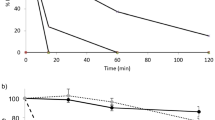Summary
Oxyntomodulin, an intestinal hormone which inhibits gastric acid secretion, is composed of glucagon and a C-terminal octapeptide. This octapeptide mimics the biological activity of the hormone. We have studied the activity of the N-acetyl octapeptide, partially protected against enzymatic degradation, on pentagastrin-, histamine- and milk meal-stimulated secretion in conscious rats and compared it to that of oxyntomodulin and its derivatives. The N-acetylated octapeptide had a 3-fold higher potency than the octapeptide on pentagastrin-stimulated secretion. On histamine-stimulated secretion, the differences between the acetylated and the free octapeptides were that the former displayed a dose-response curve parallel to that of oxyntomodulin and a 4-fold higher potency. The increase in potency appears to be related in part to a decrease in the metabolic clearance rate in vivo (6-fold) and, in vitro, to an increase in half-life (3-fold) when incubated with rat liver plasma membranes. Similarly to the free octapeptide, the acetylated form decreased acid secretion stimulated by a milk meal, when infused before the meal. Acetylation of the Lysine side chains resulted in a totally inactive molecule. The results indicate that acetylating the N-terminus of the octapeptide of oxyntomodulin increases the similarities with the natural hormone. The still large difference in potency (≈ 40-fold) between the 37-amino acid peptide and its acetylated 8-amino acid derivative is explained by the higher (≈ 40-fold) metabolic clearance rate (MCR) of the latter, indicating that further decreasing this parameter, in particular by protecting the short peptide from the enzymatic degradation, should result in a potent and efficient molecule, usable for pharmacological research and therapeutics.
Similar content being viewed by others
References
Aumelas A, Audousset-Puech M-P, Heitz A, Bataille D, Martinez J (1989) 1H NMR conformational studies on the C-terminal octapeptide of oxyntomodulin, a β-turn locked by a salt bridge. Int J Pept Prot Res 34:268–276
Audousset-Puech M-P, Jarrousse C, Dubrasquet M, Aumelas A, Castro B, Bataille D, Martinez J (1985) Synthesis of the C-terminal octapeptide of pig oxyntomodulin Lys-Arg-Asn-Lys-Asn-Asn-Ile-Ala: a potent inhibitor of pentagastrin-induced acid secretion. J Med Chem 28:1529–1533
Audousset-Puech M-P, Dufour M, Kervran A, Jarrousse C, Castro B, Bataille D, Martinez J (1986) Solid-phase synthesis of human (Nle-27)-oxyntomodulin. Preliminary evaluation of its biological activites. FEBS Lett 200:181–185
Bado A, Bataille D, Accary JP, Lewin MJM, Dubrasquet M (1988) Luminal gastric Somatostatin-like immunoreactivity in response to oxyntomodulin derivatives in cat. Biomed Res 9 [Suppl 3]:195–199
Bataille D, Coudray A-M, Carlqvist M, Rosselin G, Mutt V (1982a) Isolation of glucagon-37 (bioactive enteroglucagon/oxyntomodulin) from porcine jejuno-ileum. Isolation of the peptide. FEBS Lett 146:73–78
Bataille D, Tatemoto K, Gespach C, Jörnvall H, Rosselin G, Mutt V (1982b) Isolation of glucagon-37 (bioactive enteroglucagon/oxyntomodulin) from porcine jejuno-ileum. Characterization of the peptide. FEBS Lett 146:79–86
Bell GI, Sanchez-Pescador R, Laybourn PJ, Najarian RC (1983a) Exon duplication and divergence in the human preproglucagon gene. Nature (Lond) 304:368–371
Bell GI, Santerre RF, Mullenbach GT (1983b) Hamster preproglucagon contains the sequence of glucagon and two related peptides. Nature (Lond) 302:716–718
Blache P, Kervran A, Martinez J, Bataille D (1988) Development of an oxyntomodulin/glicentin C-terminal radioimmuno assay using a “thiol-maleoyl” coupling- method for preparing the immunogen. Anal Biochem 173:171–179
Brodie DA, Marshall RW, Moreno OM (1962) The effect of ulcerogenic drugs on gastric acidity in the rat with chronic fistula. Gastroenterology 43:675–679
Carles-Bonnet C, Jarrousse C, Niel H, Martinez J, Bataille D (1991) Oxyntomodulin and its (19–37) and (30–37) fragments inhibit histamine-stimulated gastric acid secretion in the conscious rat. Eur J Pharmacol (in press)
Chou PY, Fassman GD (1975) The conformation of glucagon: predictions and consequences. Biochemistry 14:2536–2541
Cooke AR (1978) Gastric emptying in the cat in response to hypertonic solutions and tryptophane. Dig Dis Sci 23:312–315
Depigny C, Lupo B, Kervran A, Bataille D (1984) Mise en évidence d'un site récepteur spécifique du glucagon-37 (oxyntomodulin/enteroglucagon bioactif) dans les glandes oxyntiques de rat. C R Acad Sci Paris III 299:677–680
Dubrasquet JM, Bataille D, Gespach C (1982) Oxyntomodulin (glucagon-37 or bioactive enteroglucagon): a potent inhibitor of pentagastrin-stimulated acid secretion in rat. Biosci Rep 2:391–395
Dubrasquet J, Audousset-Puech M-P, Martinez J, Bataille D (1986) Somatostatin enhances the inhibitory effect of oxyntomodulin and its C-terminal octapeptide on acid secretion. Peptides 7 [Suppl 1]:257–259
Heinrich G, Gros P, Habener JF (1984) Glucagon gene sequence. Four of six exons encode separate functional domains of rat preproglucagon. J Biol Chem 259:14082–14087
Jarrousse C, Audousset-Puech M-P, Dubrasquet M, Niel H, Martinez J, Bataille D (1985) Oxyntomodulin (glucagon-37) and its C-terminal octapeptide inhibit gastric acid secretion. FEBS Lett 188:81–84
Jarrousse C, Niel H, Audousset-Puech M-P, Martinez J, Bataille D (1986) Oxyntomodulin and its C-terminal octapeptide inhibit meal-stimulated acid secretion. Peptides 7 (S1):253–256
Jarrousse C, Carles C, Niel H, Martinez J, Bataille D (1990) Oxyntomodulin and oxyntomodulin 19–37 as regulators of gastric acid secretion. Digestion 46:(S1):47
Kervran A, Blache P, Bataille D (1987) Distribution of oxyntomodulin and glucagon in the gastro-intestinal tract and the plasma of rat. Endocrinology 121:704–713
Kervran A, Dubrasquet M, Blache P, Martinez J, Bataille D (1990) Metabolic clearance rates of oxyntomodulin and glucagon in the rat: contribution of the kidney. Regul Pept 31:41–52
Lopez LC, Frazier ML, Su C-J, Kuman A, Saunders GF (1983) Mammalian preproglucagon contains three glucagon related peptides. Proc Natl Acad Sci USA 80:5485–5489
Neville DM Jr (1968) Isolation of an organ specific protein antigen from cell-surface membrane of rat liver. Biochim Biophys Acta 154:540–552
Veyrac M, Ribard D, Daures JP, Mien H, Le Quellec A, Bataille D, Michel H (1989) Inhibitory effect of the C-terminal octapeptide of oxyntomodulin on pentagastrin-stimulated gastric acid secretion in man. Scand J Gastroenterol 24:1238–1242
Yanaihara C, Matsumoto T, Kadowaki M, Iguchi K, Yanaihara N (1985) Rat pancreas contains the proglucagon (64–69) fragment and arginine stimulates its release. FEBS Lett 187:307–310
Author information
Authors and Affiliations
Additional information
Send offprint requests to D. Bataille at the above address
Rights and permissions
About this article
Cite this article
Carles-Bonnet, C., Jarrousse, C., Niel, H. et al. N-acetyl oxyntomodulin30–37: pharmacokinetics and activity on gastric acid secretion. Naunyn-Schmiedeberg's Arch Pharmacol 345, 57–63 (1992). https://doi.org/10.1007/BF00175470
Received:
Accepted:
Issue Date:
DOI: https://doi.org/10.1007/BF00175470




